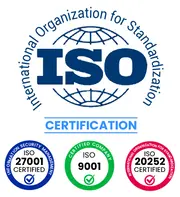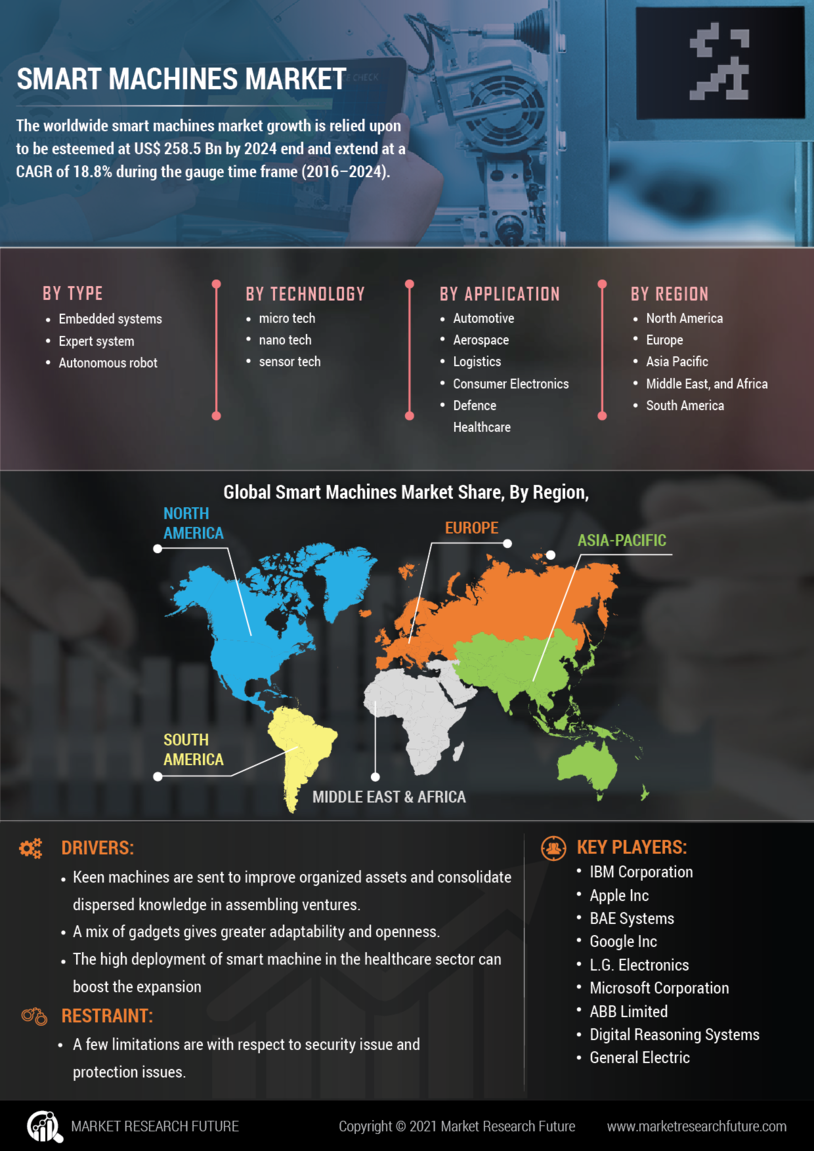Global Smart Machines Market Overview:
Smart Machines Market Size was valued at USD 269.84 Billion in 2024. The Smart Machines market industry is projected to grow from USD 331.91 Billion in 2025 to USD 2,139.08 Billion by 2034, exhibiting a compound annual growth rate (CAGR) of 23.00% during the forecast period (2025 - 2034). Self-ruling vehicles are projected to be the quickest developing section over the estimated time frame among all machine types. This is ascribed to different vehicle producers zeroing in on building autonomous vehicles that drive clients around securely are the key market drivers enhancing market growth.
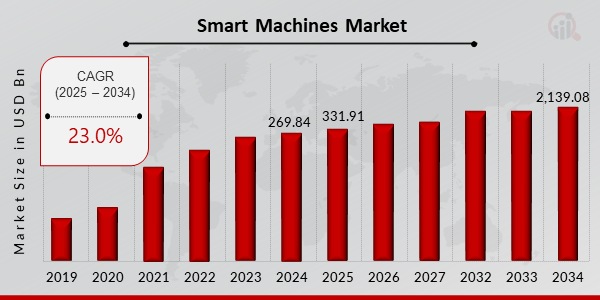
Source: Secondary Research, Primary Research, MRFR Database, and Analyst Review
Smart Machines Market Trends
- The use of Artificial Intelligence (AI) in machine learning to boost market growth
The use of artificial intelligence (AI) in machine learning is one of the key drivers of the smart machines market across the globe. Smart machines are essentially machines that can perform tasks that typically require human-like intelligence, such as reasoning, learning, and perception. artificial intelligence (AI) and machine learning technologies enable smart machines to become increasingly intelligent and sophisticated, and to operate more autonomously, with less human intervention. The smart machines market includes a wide range of industries and applications, from healthcare and transportation to manufacturing and retail. In each of these industries, AI and machine learning are helping to drive the development of smart machines that are capable of performing tasks more efficiently, accurately, and safely than ever before.
For example, in the healthcare industry, smart machines equipped with AI and machine learning algorithms are helping to diagnose and treat diseases and to improve patient outcomes. In manufacturing, smart machines are helping to optimize production processes and reduce costs, while in transportation, they are helping to improve safety and efficiency on the roads and in the skies. Overall, the use of AI and machine learning in smart machines is helping to drive innovation and growth in a wide range of industries and is expected to continue to do so in the years to come. Therefore, such factors related to Smart Machines have enhanced the Smart Machines market CAGR across the globe in recent years.
Smart Machines Market Segment Insights:
Smart Machines Type Insights
The Smart Machines Market segmentation, based on type, includes Embedded systems, Expert systems, and Autonomous robots. The Autonomous robots segment held the majority share in 2022 of the Smart Machines Market revenue. Autonomous robots are designed to operate independently, with little or no human intervention, and are often equipped with advanced sensing and perception capabilities, as well as decision-making algorithms that allow them to navigate and interact with their environment. This type of smart machine is often used in applications such as manufacturing, warehousing, and logistics, where they can perform tasks such as assembly, material handling, and inventory management.
Smart Machines Application Insights
Based on application, the Smart Machines Market segmentation includes Automotive, Aerospace, Logistics, Consumer Electronics, Defence, and Healthcare. The Consumer Electronics segment dominated the market in 2022 and is projected to be the faster-growing segment during the forecast period, 2024-2032. Consumer electronics refer to the devices and appliances used by consumers in their daily lives, such as smartphones, home appliances, and other smart devices. The consumer electronics segment of the smart machines market is often driven by the increasing demand for smart homes and the Internet of Things (IoT). Smart machines are used in consumer electronics to enable devices to perform complex functions, such as voice recognition, facial recognition, and natural language processing. These all factors for Smart Machines positively impact market growth.
Figure 2: Smart Machines Market, by Type, 2022 & 2030 (USD Billion)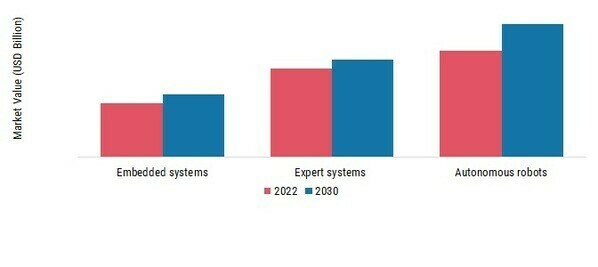
Source: Secondary Research, Primary Research, MRFR Database, and Analyst Review
Smart Machines Regional Insights
By region, the study provides market insights into North America, Europe, Asia-Pacific, and the Rest of the World. The Asia Pacific region has been experiencing significant growth in the smart machines market in recent years. This growth can be attributed to several factors, including the increasing adoption of automation and artificial intelligence technologies across various industries in the region, as well as the growing demand for smart machines in emerging economies such as China and India. The region has a large and growing population, which is driving the demand for smart machines in areas such as healthcare, consumer electronics, and transportation. The region is also home to several major manufacturing hubs, where smart machines are used to improve production efficiency, quality, and safety. Smart machines such as autonomous mobile robots (AMRs) are being used to optimize warehouse operations, reduce labor costs, and improve order fulfillment speed.
Further, the major countries studied in the market report are The U.S., Canada, Germany, France, the UK, Italy, Spain, China, Japan, India, Australia, South Korea, and Brazil
Figure 3: Smart Machines Market SHARE BY REGION 2022 (%)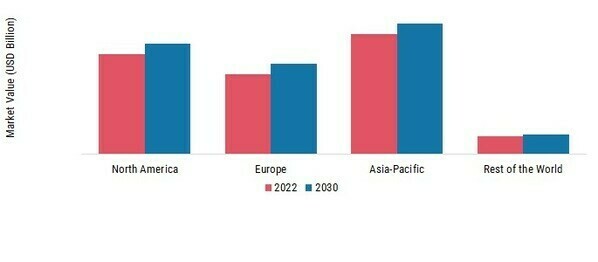
Source: Secondary Research, Primary Research, MRFR Database, and Analyst Review
Europe’s Smart Machines market accounts for the third-largest market share. The region has a highly developed manufacturing industry and is a leading market for automation and robotics. The healthcare industry in Europe is also a key application area for smart machines, with the increasing adoption of technologies such as medical imaging and robotics in surgery. Other industries where smart machines are gaining traction in Europe include logistics, consumer electronics, and defense. In addition, the region is home to many leading technology providers and research institutions, which are driving innovation and technological advancements in the smart machines market. The region also has a strong regulatory framework and intellectual property protection laws, which create a favorable business environment for smart machine manufacturers and technology providers. Further, the Germany Smart Machines market held the largest market share, and the UK Smart Machines market was the fastest-growing market in the European region.
North America is one of the key regions in the Smart Machines Market. The region is home to many leading manufacturers and technology providers, as well as some of the largest end-users of smart machines in industries such as automotive, aerospace, and consumer electronics. The region is also known for its high level of adoption of automation and artificial intelligence technologies in various industries, which has created a strong demand for smart machines. In addition, the region's well-established regulatory framework and strong intellectual property protection laws have created a favorable business environment for smart machine manufacturers and technology providers. North America is also home to many leading universities and research institutions, which have been driving innovation in the smart machines market. Moreover, the U.S. Smart Machines market held the largest market share, and the Canada Smart Machines market was the fastest-growing market in the North American region.
Smart Machines Key Market Players & Competitive Insights
Major market players are spending a lot of money on R&D to increase their product lines, which will help the Smart Machines market grow even more. Market participants are also taking a range of strategic initiatives to grow their worldwide footprint, with key market developments such as new product launches, contractual agreements, mergers and acquisitions, increased investments, and collaboration with other organizations. Competitors in the Smart Machines industry must offer cost-effective items to expand and survive in an increasingly competitive and rising market environment.
The major market players are investing a lot of money in R&D to expand their product lines, which will spur further market growth for Smart Machines. With significant market development like new product releases, contractual agreements, mergers and acquisitions, increased investments, and collaboration with other organizations, market participants are also undertaking various strategic activities to expand their global presence. To grow and thrive in a market climate that is becoming more competitive and growing, competitors in the Smart Machines industry must offer affordable products.
Manufacturing locally to cut operating costs is one of the main business tactics manufacturers use in the global Smart Machines industry to benefit customers and expand the market sector. Major Smart Machines market players, including IBM Corporation, Apple Inc, BAE Systems, Google Inc., L.G. Electronics, Microsoft Corporation, ABB Limited, Digital Reasoning Systems, Inc. and General Electric Co., and others, are attempting to increase market demand by funding R&D initiatives.
IBM Corporation, also known as IBM, is a multinational technology company. IBM operates in various segments, including Cloud & Cognitive Software, Global Business Services, Global Technology Services, Systems, and Global Financing. The company offers a wide range of products and services, including hardware, software, consulting, and IT services. IBM has a long history of innovation, and the company is widely recognized for its contributions to the development of the modern computing industry.
Apple Inc. is a multinational technology company and is one of the world's largest technology companies. Apple operates in various segments, including the iPhone, Mac, iPad, wearables, home and accessories, and services. The company is best known for its innovative consumer electronics products, including the iPhone, iPad, and Mac computers. Apple's product line is known for its sleek design, user-friendly interfaces, and high-quality performance. In addition to its hardware products, Apple offers a wide range of services, including the App Store, Apple Music, Apple TV+, and iCloud. Apple is also a leader in the mobile operating system space, with its iOS operating system powering its iPhone and iPad products. The company has a strong ecosystem of products and services that work seamlessly together, allowing users to easily move between their iPhone, iPad, Mac, and other Apple devices.
Key Companies in the Smart Machines market include
Smart Machines Industry Developments
January 2020: IBM announced the launch of Advertising Accelerator with Watson to predict the optimal combination of creative elements to help drive high engagement and conversion for a given audience.
Smart Machines Market Segmentation
Smart Machines Type Outlook
Embedded systems
Expert system
Autonomous robot
Smart Machines Application Outlook
Automotive
Aerospace
Logistics
Consumer Electronics
Defense
Healthcare
Smart Machines Regional Outlook
-
Europe
- Germany
- France
- UK
- Italy
- Spain
- Rest of Europe
- Asia-Pacific
- China
- Japan
- India
- Australia
- South Korea
- Australia
- Rest of Asia-Pacific
-
Rest of the World
Middle East
Africa
Latin America
| Attribute/Metric |
Details |
| Market Size 2024 |
USD 269.84 Billion |
| Market Size 2025 |
USD 331.91 Billion |
| Market Size 2034 |
USD 2139.08 Billion |
| Compound Annual Growth Rate (CAGR) |
23.00% (2025-2034) |
| Base Year |
2024 |
| Market Forecast Period |
2025-2034 |
| Historical Data |
2020 & 2023 |
| Market Forecast Units |
Value (USD Million) |
| Report Coverage |
Revenue Forecast, Market Competitive Landscape, Growth Factors, and Trends |
| Segments Covered |
Type, Application, and Region |
| Geographies Covered |
North America, Europe, Asia Pacific, and Rest of the World |
| Countries Covered |
The U.S, Canada, Germany, France, UK, Italy, Spain, China, Japan, India, Australia, South Korea, and Brazil |
| Key Companies Profiled |
IBM Corporation, Apple Inc, BAE Systems, Google Inc., L.G. Electronics, Microsoft Corporation, ABB Limited, Digital Reasoning Systems, Inc. and General Electric Co |
| Key Market Opportunities |
The rising interest in ceaseless patient consideration and observation has been fuelling interest in intelligent machines |
| Key Market Dynamics |
Rising applications in healthcare, automotive, consumer electronics, and military, industrial, aerospace & defense are pushing the growth |
Smart Machines Market Highlights:
Frequently Asked Questions (FAQ):
The Smart Machines Market size was valued at USD 269.84 Billion in 2024.
The global market is projected to grow at a CAGR of 23.00% during the forecast period, 2025-2034
Asia Pacific had the largest share in the Smart Machines Market.
The key players in the market are IBM Corporation, Apple Inc, BAE Systems, Google Inc., L.G. Electronics, Microsoft Corporation, ABB Limited, Digital Reasoning Systems, Inc. and General Electric Co.
The autonomous robot category dominated the market in 2022.
Consumer electronics had the largest share in the global market for Smart Machines.

